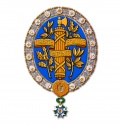Luzy-Saint-Martin: Difference between revisions
Knorrepoes (talk | contribs) m (Text replacement - "Literature : " to "'''Literature''': ") |
Knorrepoes (talk | contribs) m (Text replacement - "↵{{media}}" to " {{fr1}} {{media1}}") Tags: Mobile edit Mobile web edit |
||
| Line 34: | Line 34: | ||
[[Civic Heraldry Literature - France|'''Literature''']]: Image from http://www.armorialdefrance.fr | [[Civic Heraldry Literature - France|'''Literature''']]: Image from http://www.armorialdefrance.fr | ||
{{ | {{fr1}} | ||
{{media1}} | |||
[[Category:French Municipalities L]] | [[Category:French Municipalities L]] | ||
[[Category:Meuse]] | [[Category:Meuse]] | ||
[[Category:Granted 2021]] | [[Category:Granted 2021]] | ||
Revision as of 12:59, 26 December 2022
French heraldry portal
This page is part of the French heraldry portal |
Heraldry of the World |
|
French heraldry:
Overseas territories:
|
Selected collector's items from France:
|
LUZY-SAINT-MARTIN
Département : Meuse
| French | D'or à la tête de lion arrachée de sable surmontant deux scies crocodiles d'azur emmanchées de gueules posées hautes, adossées, en chevron renversé; chapé de gueules chargé à dextre d'une fleur d'iris des marais d'or et à senestre d'une grappe de raisin tigée, feuillée et fruitée du même. |
| English | No blazon/translation known. Please click here to send your (heraldic !) blazon or translation |
Origin/meaning
The arms were officially adopted on April 9, 2021.
Marsh irises symbolise the aquatic, marshy environment and are also cating, Luzy is derived from the Latin lutum: marsh.
The division of the field refers to the local patron saint, St. Martin of Tours, who cut his cloak in half to give it to a beggar. This is thus canting for the second half of the name.
The lion's head is taken from the arms of the Richer family, medieval lords of the village.
The saws symbolise the local importance of cut stones extracted from the quarries of Luzy until the middle of the 19th century. It was siliceous stone mainly used indoors.
The bunch of grapes illustrates the importance of viticulture until the end of the 19th century.
The gray herons supporters are those of the famous heronry sheltered by the forest of Jaulnay.
Literature: Image from http://www.armorialdefrance.fr


